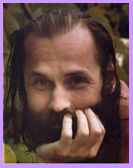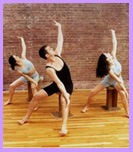|
|
|
|
The Gyrotonic Expansion System
A daringly curvaceous silhouette
balanced by a broad frame. Intimidating? Maybe. Impossible? Hardly. Suggestive
of raw power and reflecting natural beauty, the Gyrotonic Expansion System inspires
those who see it for the first time. Rivaling other home-gym machines, the system
boasts a body composed of wood, aluminum, and pulleys. “It’s a sexy
machine,” said Pilates instructor “Ben”.  “It
helps articulate the joints and opens everything up.” Ben teaches Pilates
at Chelsea Movements, a Manhattan studio specializing in Pilates and Gyrotonics.
The Gyrotonic Expansion System evolved from gyrokinetics, a low-resistance exercise
method that simulates popular activities such as swimming and ballet.
“It
helps articulate the joints and opens everything up.” Ben teaches Pilates
at Chelsea Movements, a Manhattan studio specializing in Pilates and Gyrotonics.
The Gyrotonic Expansion System evolved from gyrokinetics, a low-resistance exercise
method that simulates popular activities such as swimming and ballet.
The concept surrounding gryokinetics is based on aspects of dance, yoga, tai
chi, and gymnastics. Developed in the 1980’s by Hungarian dancer Juliu
Horvath, the practice has often been dubbed “yoga for dancers”. After
years working as a professional dancer, Horvath ruptured an Achilles tendon,
motivating him to begin a serious study of yoga. During his study, he crafted
a series of exercises he called gyrokinetics that concentrated on combining
specific patterns of breathing with three-dimensional, circular movement. This
distinguishes gyrokinetics from the more linear Pilates, and allows for a sense
freedom that some find lacking in yoga poses which one must hold for long periods
of time. This practice aims to lengthen muscles, articulate joint movement,
and improve technique for dancers (and coordination for everyone else).
 After
developing his series, Horvath worked to create a related machine that would
allow for the necessary precision in movement to guide dancers toward tighter
turns and a more refined technique. The result was the Gyrotonic Expansion System,
a tower of pulleys connected to a bench with two horizontal wheels at the end.
At the beginning, Horvath built every machine himself using little more than
a jigsaw. Now, the addition of technology to the equation has decreased the
building time, but Horvath continues to oversee the process. Horvath also teaches
monthly sessions in gyrokinesis in Manhattan.
After
developing his series, Horvath worked to create a related machine that would
allow for the necessary precision in movement to guide dancers toward tighter
turns and a more refined technique. The result was the Gyrotonic Expansion System,
a tower of pulleys connected to a bench with two horizontal wheels at the end.
At the beginning, Horvath built every machine himself using little more than
a jigsaw. Now, the addition of technology to the equation has decreased the
building time, but Horvath continues to oversee the process. Horvath also teaches
monthly sessions in gyrokinesis in Manhattan.
Gyrotonics, as the genre is now called, has been embraced by celebrities such as Madonna and Gwenyth Paltrow and continues to thrive internationally. Gyrotonic machines can be found in dance studios, rehabilitation centers, and sports facilities.
Along with personal training sessions on a Gyrotonic Expansion System machine, many studios offer Gyrokinesis classes. Such classes begin with students seated on stools only 16 to 18 inches in height. From this position, students gradually expand their range of motion, adding new muscle groups and increasing the level of difficulty.
While popular among the dancing community, gyrokinesis has also proven a high rate of success in increasing the capabilities of both children and the elderly. The Gyrotonic Expansion System is adjustable to any resistance (generally no more than 30 lbs.) and any range of motion, no matter how small or large. The method’s accessibility is a profound contributor to its rising success, and the possibility of recognizing its followers by the poise with which they walk may not be so unusual in the years to come.
For more information, visit www.gyrotonic.com.
New Yorker’s click here to find out more about our low rate advertising for this page.
 |
|
 |

|
||
|
©
Melt Magazine 2005
|
||